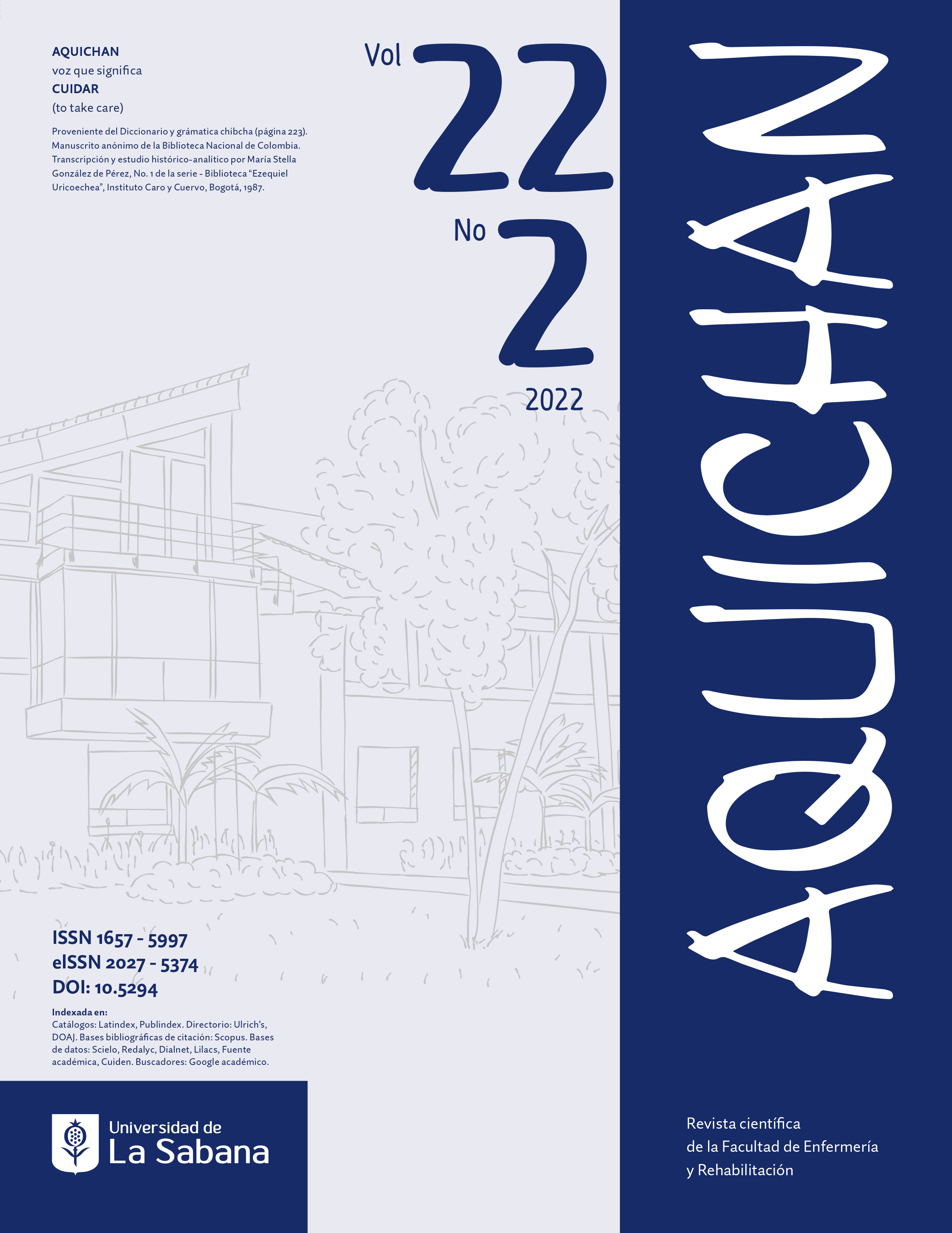Adaptation and Validation of the Tuberculosis Related Stigma Scale in Portuguese
DOI:
https://doi.org/10.5294/aqui.2022.22.2.6Keywords:
Nursing, social stigma, tuberculosis, validation study, surveys and questionnairesAbstract
Objective: To adapt and validate the Tuberculosis Related Stigma Scale (TRSS) in European Portuguese. Materials and method: A methodological study in a sample of 204 individuals being treated for pulmonary tuberculosis in Portuguese Pulmonary Diagnostic Centers, with at least one month of treatment or in follow-up. The evaluation process of linguistic and conceptual equivalence involved translation, the consensus among judges, back-translation, semantic validation, and pre-testing of the TRSS. The scale’s psychometric properties were assessed by verifying the reliability and validity of the results and calculating Cronbach’s alpha coefficient and the exploratory factor analysis of principal components, with Varimax rotation of the scale items. Results: The Portuguese version of the TRSS has a Cronbach’s alpha coefficient of 0.94 and has 23 items distributed in two dimensions: “Community’s perspectives on tuberculosis” (11 items) and “Person’s perspectives on tuberculosis” (12 items). Its psychometric characteristics ensure adequate reliability and validity for the Portuguese population. Conclusions: The TRSS is a valid and reliable instrument to assess stigma in people with pulmonary tuberculosis and, to date, the only scale validated in this domain for the Portuguese population, which allows nurses to make an integrated intervention.
Downloads
References
Direção-Geral da Saúde. Temas da saúde: Tuberculose [internet]; 2021[citado 13 nov. 2021]. Disponível em: https://www.sns24.gov.pt/tema/doencas-infecciosas/tuberculose/
World Health Organization.Global Tuberculosis Report; 2018 [internet]; 2018[cited 2020 Oct 30]. Available from: https://apps.who.int/iris/handle/10665/274453
World Health Organization. Global Tuberculosis Report; 2020 [internet]; 2020[cited 2020 Dec 05]. Available from: https://apps.who.int/iris/bitstream/handle/10665/336069/9789240013131-eng.pdf
World Health Organization. WHO end TB strategy: Global strategy and targets for tuberculosis prevention, care and control after 2015 Report; 2015 [internet]; 2015[cited 2020 Oct 30]. Available from: https://www.who.int/tb/post2015_strategy/en/
Serviço Nacional de Saúde. Serviço Nacional de Saúde [internet]; 2019[citado 27 out. 2020]. Disponível em: https://www.sns.gov.pt/noticias/2019/03/25/tuberculose-reducao-de-casos/
Direção Geral de Saúde [internet]; 2018[citado 27 out. 2020]. Disponível em: https://www.dgs.pt/documentos-e-publicacoes/tuberculose-em-portugal-desafios-e-estrategias-2018-.aspx
Administração Regional de Saúde do Norte. Vigilância Epidemiológica [internet]; 2020[citado 29 nov. 2020]. Disponível em: http://www.arsnorte.min-saude.pt/vigilancia-epidemiologica/tuberculose/ - content
Veiga AC. Controlo da tuberculose em Portugal continental: estudo do insucesso terapêutico e dos seus factores nos doentes pulmonares para optimização do Programa Nacional [dissertação de mestrado]. Lisboa: Escola Nacional de Saúde Publica, Universidade Nova de Lisboa [internet]; 2016[citado 29 nov. 2020]. Disponível em: https://run.unl.pt/bitstream/10362/20089/1/RUN%20-%20Tese%20de%20Doutoramento%20-%20Ana%20Margarida%20Veiga.pdf
Zhang H, Ehiri J, Yang H, Tang S, Li Y. Impact of community-based DOT on tuberculosis treatment outcomes: A systematic review and meta-analysis. PLoS One. 2016;11(2):e0147744. DOI: https://doi.org/10.1371/journal.pone.0147744
Ayakaka I, Ackerman S, Ggita JM, Kajubi P, Dowdy D, Haberer JE et al. Identifying barriers to and facilitators of tuberculosis contact investigation in Kampala, Uganda: A behavioral approach. Implement Sci. 2017;12(1):33. DOI: https://doi.org/10.1186/s13012-017-0561-4
Sommerland N, Wouters E, Mitchell EMH, Ngicho M, Redwood L, Masquillier C et al. Evidence-based interventions to reduce tuberculosis stigma: A systematic review. Int J Tuberc Lung Dis. 2017;21(11):81-86. DOI: https://doi.org/10.5588/ijtld.16.0788
Nyblade L, Stockton MA, Giger K, Bond V, Ekstrand ML, Lean RM et al. Siraprapasiri T, Turan J, Wouters E. Stigma in health facilities: why it matters and how we can change it. Stigma in health facilities: Why it matters and how we can change it. BMC Med. 2019;17(1):25. DOI: https://doi.org/10.1186/s12916-019-1256-2
Nkambule B, Lee-Hsieh J Liu C-Y, Cheng, S-F. The relationship between patients’perception of nurse caring behaviors andtuberculosis stigma among patients with drug-resistant tuberculosis inSwaziland. International Journal of Africa Nursing Sciences. 2019;10:14-8. DOI: https://doi.org/10.1016/j.ijans.2018.11.004
Bonadonna LV, Saunders MJ, Zegarra R, Evans C, Alegria-Flores K, Guio H. Why wait? The social determinants underlying tuberculosis diagnostic delay. PLoS One. 2017;12(9):e0185018. DOI: https://doi.org/10.1371/journal.pone.0185018
Goffman E. Estigma: notas sobre a manipulação da identidade deteriorada. 4ª ed. Rio de Janeiro: Ed. Guanabara; 2004.
Van Rie A, Sengupta S, Pungrassami P, Balthip Q, Choonuan S, Kasetjaroen Y et al. Measuring stigma associated with tuberculosis and HIV/AIDS in southern Thailand: Exploratory and confirmatory factor analyses of two new scales. Trop Med Int Health. 2008;13(1):21-30. DOI: https://doi.org/10.1111/j.1365-3156.2007.01971.x
Internacional Test Commission. The ITC Guidelines for Translating and Adapting Testes. 2nd ed. [internet]; 2017[internet]; 2018[citado 22 nov. 2020]. Disponível em: https://www.intestcom.org/files/guideline_test_adaptation_2_brasilian_portuguese.pdf
Ximenes RRC, Carvalho ZMF, Coutinho JFV, Braga DCO, Coelho JMA, Studart RMB, et al. Cross-cultural adaptation and validation of the Intermittent Self-Catheterization Questionnaire. Rene.2018;19:e3315. DOI: https://doi.org/10.15253/2175-6783.2018193315
Reis LR, Donato M, Sousa R, et al. Tradução, adaptação cultural e validação da escala Satisfaction with Amplification in Daily Life para o Português de Portugal. Acta Médica Portuguesa. 2017;30(2):115-21. DOI: https://doi.org/10.20344/amp.7794
Epstein J, Santo RM, Guillemin F. A review of guidelines for cross-cultural adaptation of questionnaires could not bring out a consensus. J Clin Epidemiol. 2015;68(4):435-41. DOI: https://doi.org/10.1016/j.jclinepi.2014.11.021
Almeida L, Freire T. Metodologia da Investigação em Psicologia e Educação. 5ª ed. Braga: Psiquilíbrios; 2017.
Marôco J. Análise Estatística com o SPSS Statistics. 8ª ed. Pêro Pinheiro: ReportNumber, editor; 2021.
Watson JC. Establishing evidence for internal structure using exploratory factor analysis. Measurement and Evaluation in Counseling and Development. 2017;50:232-8. DOI: https://doi.org/10.1080/07481756.2017.1336931
Downloads
Published
How to Cite
Issue
Section
License
Copyright (c) 2022 Aquichan

This work is licensed under a Creative Commons Attribution-NonCommercial-NoDerivatives 4.0 International License.
1. Proposed Policy for Journals That Offer Open Access
Authors who publish with this journal agree to the following terms:
- The journal and its papers are published with the Creative Commons License Attribution-NonCommercial-NoDerivatives 4.0 International (CC BY-NC-ND 4.0). You are free to share copy and redistribute the material in any medium or format if you: give appropriate credit, provide a link to the license, and indicate if changes were made; don’t use our material for commercial purposes; don’t remix, transform, or build upon the material.









